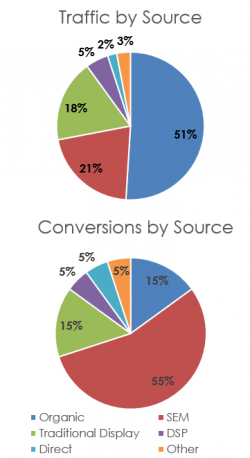How to Allocate Your Marketing Budget in a Down Economy
Here at Vovia, we’re usually talking about opportunities to increase your digital presence and add new channels to your mix. But, what happens when the economic climate is less than favourable? Budget cuts to marketing departments are pretty common when times are tough, but what to cut is the million dollar question…

Today I’m going to talk about managing your marketing spend when you need to work with less.
Doing More with Less
If you need to cut back, it makes sense to cut back on channels that are less efficient at driving results. Identifying these channels can be tricky, but the best place to start is to look at the data, and by this I mean your system of record. For most organizations, your system of record is your website analytics package or Google Analytics.
 A good place to start is to look at all of your website traffic and see which sources are driving that traffic. Then, dive into your conversion or engagement data and take a look at the sources that drive those conversions. Does most of your traffic come from organic sources, while most conversions are coming from your SEM campaign? If so, that’s a strong indicator that you should not be cutting SEM budget when times are tough as it is contributing more to your ultimate bottom line.
A good place to start is to look at all of your website traffic and see which sources are driving that traffic. Then, dive into your conversion or engagement data and take a look at the sources that drive those conversions. Does most of your traffic come from organic sources, while most conversions are coming from your SEM campaign? If so, that’s a strong indicator that you should not be cutting SEM budget when times are tough as it is contributing more to your ultimate bottom line.
Maybe you’ve sponsored a webinar on another site and you notice that the referral traffic to your site is pretty strong, but that traffic rarely converts. Webinars might be a great way to build awareness and demonstrate thought leadership, but if those visitors aren’t moving down the funnel, you’ll want to consider scaling back your investment in that activity. It might mean 2 webinars per year instead of 4.
The scenario above makes it pretty easy to look at the data and understand where to scale up or down, but what happens if you don’t have a consistent measurement practice in place?
Analytics Are Everything!
When faced with budget cuts it can be tempting to axe all new initiatives and scale back existing channels. But, this is when I’d argue that you need to INVEST in analytics. Emarketer found that more than 7 out of 10 marketing executives plan on increasing their reliance on data and analytics in the next 3 years. If you don’t understand what works for you, it will be that much more difficult to get back on track when budgets are restored. By understanding how your channels contribute to the overall mix, you are in a much better position to mitigate the lows, and capitalize on the highs.
In fact, Nucleus Research recently published a study that found for every dollar invested in analytics, the ROI was over $13. What other marketing activity can deliver this kind of value?
Investing in measurement doesn’t mean you need pricey analytics software. Google Analytics (GA) is free and is sufficient for most large organizations. What you do need to commit to is a consistent tagging process so that all in-bound behaviour is accurately reported and can be compared in your system of record (GA). You’ll also need to commit to regular measurement and review cycles so that you can evaluate your channels and adjust spend levels accordingly.
Analytics & Revenue
If you’re working on a weighted revenue model, you’ll be able to able to understand how much revenue is generated by each of your channels. It’s much easier to justify an increase to your budget or protect against cuts when you can demonstrate that your SEM campaign brings in $2 for each $1 of ad spend. If you’re not set up with a weighted revenue model to measure the actions that users take on your website, why not? Weighted revenue allows you to quantify actions and determine the ROI of your channels, visitors, and marketing activities.
The bottom line is that marketers armed with data are able to demonstrate the value of their activities and cut strategically, and in a way that minimizes performance decreases.
Are you trying to understand the performance of each of your marketing channels but don’t know where to start? Feel free to reach out and let us know how we can help you.
